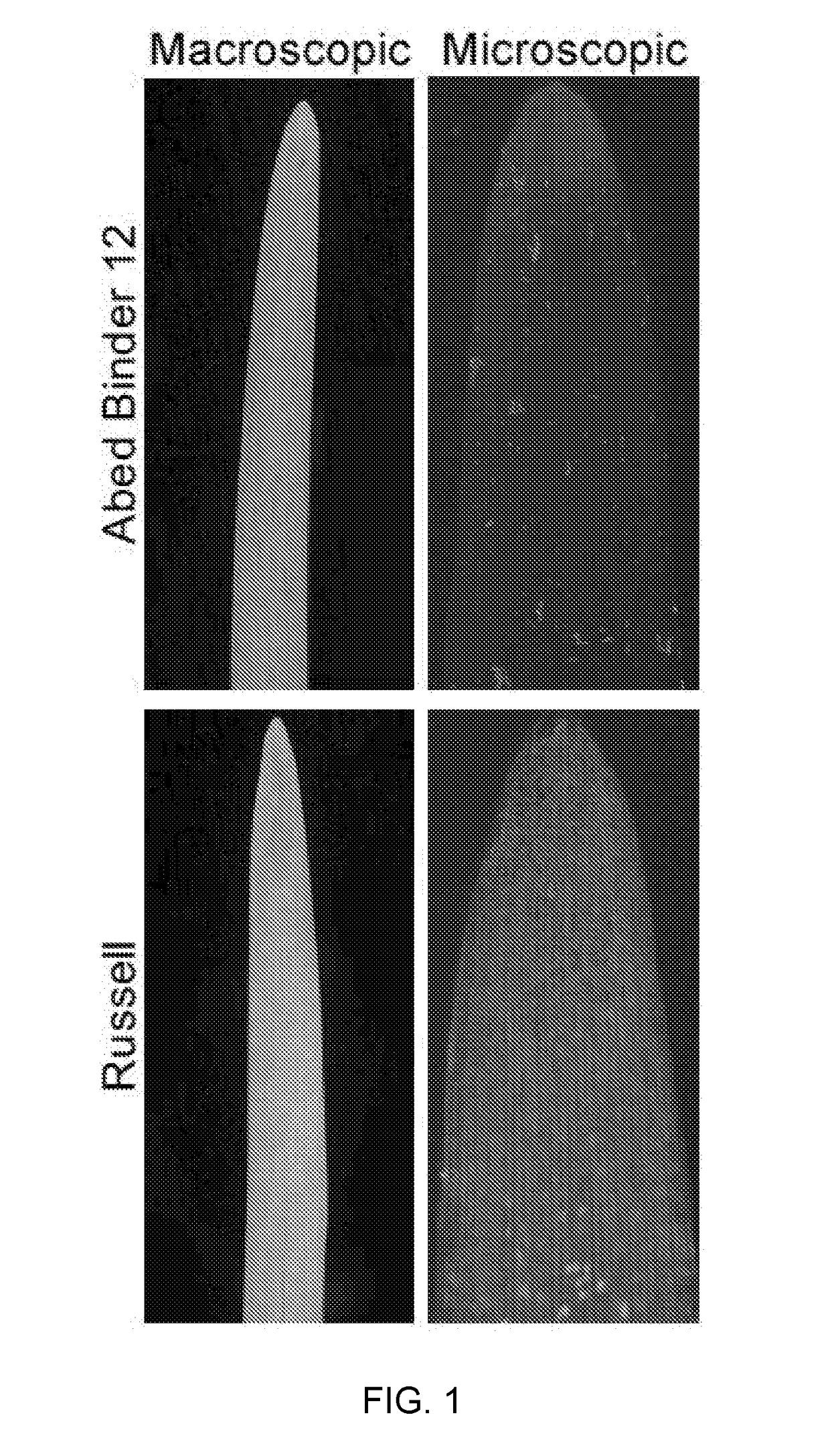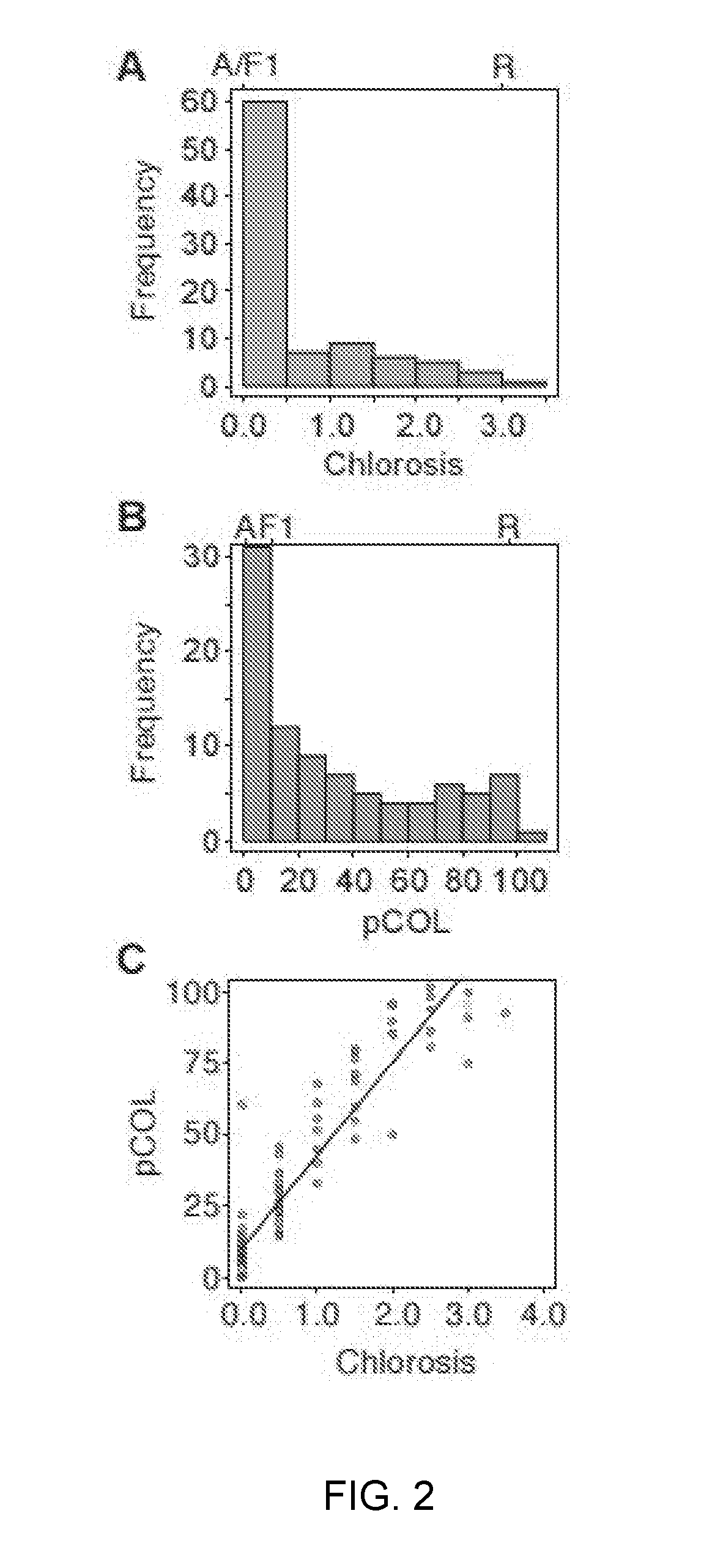Wheat stripe rust resistance genes and methods of use
a technology of rust resistance and wheat stripe, which is applied in the field of gene isolation and plant improvement, can solve the problems of significant yield loss in world-wide wheat production, high cost of pesticides, and most damaging diseases of wheat stripe, and achieve the effect of strengthening resistance to ps
- Summary
- Abstract
- Description
- Claims
- Application Information
AI Technical Summary
Benefits of technology
Problems solved by technology
Method used
Image
Examples
example 1
Isolation and Fine Mapping of Rps6
[0229]Mapping of Rps6: Differential phenotypes were observed between Abed Binder 12 and Russell inoculated with Pst isolates 08 / 501 and 08 / 21. Russell rarely showed pustules but had a clear microscopic phenotype of colonization (FIG. 1). We inoculated the Abed Binder 12 x Russell F2 populations with Pst isolate 08 / 501 (AxR-P st). The parents, F1 and 92 F2 plants were phenotyped using macroscopic and microscopic evaluation of Pst colonization (pCOL). Pustule formation was not observed for the AxR-Pst F2 population, although segregation was observed for chlorosis and pCOL (FIG. 2A-2B). A strong correlation between chlorosis and pCOL was observed (r2=0.88) (FIG. 2C). The F1 displayed a similar resistant phenotype to Abed Binder 12. To map resistance to Pst, we genotyped the AxR-Pst F2 population with the barley oligonucleotide assay (BOPA1; 1,536 SNP-based markers; Close et al. 2009). A total of 535 polymorphic OPA markers were identified between Abed ...
example 2
Transformation of Barley with Rps6 and Testing for Wheat Stripe Rust Resistance
[0255]Yeo et al. ((2014) Theor. Appl. Genet. 127:325-337) previously established the doubled haploid population SusPtrit x Golden Promise (SxGP DH) to identify a transformable barley accession that was also susceptible to several heterologous rusts of barley. We found that the accession SxGP DH-47 was susceptible to wheat stripe rust and had previously been shown to be competent for Agrobacterium-based transformation (Yeo et al. (2014) Theor. Appl. Genet. 127:325-337). Transformation of SxGP DH-47 barley is performed as described by Bartlett et al. ((2008) Plant Methods 4:22) with a modification on the use of immature embryo-derived callus for infection with Agrobacterium tumefaciens rather than immature embryos. Briefly, immature embryos are harvested from barley plants grown in a greenhouse, with embryos approximately 1.5 to 2 mm in diameter. In contrast to Bartlett et al. ((2008) Plant Methods 4:22), i...
example 3
Transformation of Wheat with Rps6 and Testing for Wheat Stripe Rust Resistance
[0257]Transformation of wheat (Triticum aestivum ‘Fielder’) is carried out as described by Periyannan et al. ((2013) Science 341: 786-788). T-DNA inserts include the original promoter and coding sequences for NLR-A (SEQ ID NO: 17) from barley contained in one of the T-DNA plasmids (SEQ ID NO: 15, 34, or 35) described in Example 2, as well as the genomic segment of the open reading frame of NLR-A (SEQ ID NO: 2) fused to a promoter and terminator from a highly expressed NLR gene from wheat. Phenotypic screens for resistance or susceptibility of transformed wheat plants to wheat stripe rust will be carried out as described above in Example 2 for barley.
PUM
| Property | Measurement | Unit |
|---|---|---|
| Fraction | aaaaa | aaaaa |
| Fraction | aaaaa | aaaaa |
| Fraction | aaaaa | aaaaa |
Abstract
Description
Claims
Application Information
 Login to View More
Login to View More - R&D
- Intellectual Property
- Life Sciences
- Materials
- Tech Scout
- Unparalleled Data Quality
- Higher Quality Content
- 60% Fewer Hallucinations
Browse by: Latest US Patents, China's latest patents, Technical Efficacy Thesaurus, Application Domain, Technology Topic, Popular Technical Reports.
© 2025 PatSnap. All rights reserved.Legal|Privacy policy|Modern Slavery Act Transparency Statement|Sitemap|About US| Contact US: help@patsnap.com



